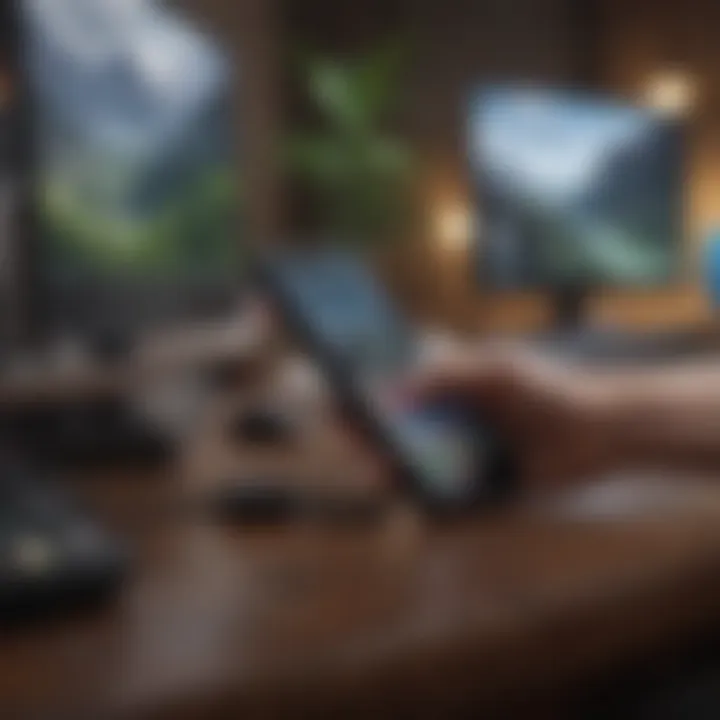How to Block Your Stolen Phone: A Complete Guide


Intro
In a world where smartphones have become almost an extension of ourselves, losing one can feel devastating. The immediate concern is not just the cost of the device itself, but the personal information stored within it. Whether it is bank details, emails, or photos, a stolen phone can lead to significant privacy risks. Taking the right actions promptly is crucial in safeguarding your personal data after a theft. This guide provides you with a comprehensive look at how to block your phone when it is stolen. You will learn about the necessary steps for both iOS and Android devices, as well as essential precautions to take following a theft.
Understanding the importance of these safety measures can help you respond quickly and minimize potential damage. Let's explore the methods available and why each one holds importance in protecting your data during such an unfortunate event.
Overview of Device Protection
Definition
Device protection refers to the measures taken to secure your smartphone from unauthorized access, especially in the event of a theft. This protection can include software solutions, built-in features of the operating system, and physical security practices.
Key Features
- Remote Locking: This feature allows users to lock their phones from a distance, preventing unauthorized access.
- Tracking Services: These let users locate their lost devices on a map, providing crucial information for recovery.
- Data Wiping: In serious cases, remotely erasing all data to prevent misuse is an option available to users.
- Account Management: Ensuring you can manage your accounts associated with the device easily.
Purpose and Benefits
The main purpose of blocking a stolen phone is to secure personal data from falling into the wrong hands. The benefits include:
- Preventing Identity Theft: By blocking your device, you thwart potential identity theft efforts.
- Protecting Sensitive Information: Important data like bank details can be safeguarded from exploitation.
- Increasing Chances of Recovery: Tracking features can sometimes help in locating and recovering the stolen phone.
Steps to Block Your Phone
For iOS Devices
- Sign in to iCloud: Visit iCloud.com and log in with your Apple ID.
- Access Find My iPhone: Select “Find iPhone” from the available options.
- Select Your Device: From the drop-down menu, choose the device you want to lock.
- Put on Lost Mode: This allows you to lock your phone, display a message, and track its location.
- Erase Device (If Necessary): If recovery seems impossible, initiate a data wipe.
For Android Devices
- Go to Find My Device: Access this via Google's Find My Device.
- Log in: Sign in using your Google account linked to the device.
- Select Your Device: Ensure you choose the correct one from the list.
- Choose Lock or Erase: Lock the device or erase all data depending on your situation.
Post-Theft Precautions
After you have blocked your phone, consider other actions to strengthen your security:
- Change Passwords: Update passwords for apps and services that were logged in on the device.
- Alert Your Bank: Inform your bank and any financial institutions about the theft.
- Review Account Activity: Keep an eye on account statements and reports for any suspicious activity.
- File a Police Report: In many cases, reporting to local authorities can be beneficial for recovery.
Blocking your phone after it is stolen is only one aspect of the broader security landscape. By taking these steps seriously, you not only protect your data but also enhance your overall security practices moving forward. The next sections will delve deeper into the available features and best practices related to phone security.
Understanding Phone Theft
In today’s world, mobile phones are not just communication devices. They store a significant amount of personal information, including contacts, photos, and payment details. This makes understanding the reality of phone theft crucial in protecting oneself. Recognizing this issue can empower individuals to take effective action when faced with the unfortunate event of theft.
The modern smartphone offers countless features but also becomes a target for theft. The increase in phone value and dependence on them has led to a rise in such incidents. By understanding the patterns and reasons behind phone theft, users can better prepare themselves both before and after an incident occurs. This knowledge serves as a vital foundation to implement safety measures.
Awareness reduces risks. Knowing how and why phones are stolen provides the insight necessary to prevent such occurrences.
The Impact of Phone Theft
The consequences of phone theft extend beyond the immediate loss of the device. When a phone is stolen, it can lead to significant emotional distress and financial strain. Users may feel violated and vulnerable, knowing that someone now has access to their private data. Furthermore, the potential for identity theft looms large. Stolen phones can provide personal information that criminals can exploit for malicious purposes.
Also, there are practical implications. The cost to replace a stolen phone can be substantial, especially if the individual has an expensive model. Beyond the monetary aspect, losing critical app access, such as banking or email, can disrupt daily life.
Common Theft Scenarios
Understanding common theft scenarios helps identify how one can be better prepared against potential theft.
- Public Transport: Crowded environments make it easy for thieves to snatch phones without drawing attention.
- Restaurants and Cafes: Leaving a phone unattended on the table is a frequent target for thieves. They can easily pick it up while the owner is distracted.
- Street Theft: This involves direct confrontation, where an assailant forcibly takes the phone from the user, often in broad daylight.
- Online Scams: Sometimes, thieves trick individuals into giving away personal information or even access to their devices through fake websites or phone calls.
By being aware of these scenarios, individuals can develop a cautious mindset, actively reducing the risk of phone theft.


Immediate Actions After Phone Theft
In the wake of a phone theft, maintaining composure can significantly affect the efficacy of your response. Immediate actions taken can not only protect your personal information but also increase the likelihood of recovering the device. Every second counts, and having clear steps can assist in the chaotic moments after the incident.
Stay Calm and Assess the Situation
When you discover that your phone is missing, your first impulse may be panic or frustration. However, it is essential to stay calm. A clear mind can help you think critically about your next steps.
Begin by assessing the circumstances. Consider whether you truly lost your phone or if it was stolen. Was there a specific moment when you last saw it? Thinking back can provide clarity.
Documenting the situation can also be beneficial. Take note of the time, location, and any possible suspects. Details can aid in reporting to the authorities.
A composed approach often leads to clearer decisions.
Retrace Your Steps
Once you have calmed down, the next logical step is to retrace your steps. Go back to the last place you remember having your phone. Often, phones are left behind in public spaces, such as cafés, shops, or at home.
Check for any lost and found services in these locations. Engaging with employees may yield results, as they often assist patrons who misplace items.
This approach can also work in tandem with locating your device through available tools. If you believe your phone is within reach, tools such as Find My iPhone for Apple users or Find My Device for Android devices can help pinpoint its location.
During this process, keep an eye out for anything unusual that could indicate theft. If you suspect foul play, prioritize your safety and consider contacting the authorities.
How to Block Your Phone Remotely
Locking your phone remotely is a critical step to minimize the risk posed by phone theft. When a device is stolen, the potential for unauthorized access to your private information increases significantly. By blocking your phone, you effectively safeguard your data and maintain control over your personal information. Understanding the methods for remote blocking is essential for any smartphone user.
Blocking an iPhone
Using Find My iPhone
Find My iPhone is a highly effective tool for those who own an iOS device. This built-in feature allows users to locate, lock, or erase their iPhone. It is convenient because it works seamlessly with Apple's ecosystem. One key characteristic of Find My iPhone is its ability to track the last known location of your device. This can be crucial in recovering a lost phone.
The primary advantage of using Find My iPhone is its user-friendly interface. Users can initiate actions with just a few taps on another Apple device. However, this service requires that you enable it on your phone beforehand. If not activated prior to theft, it may not be helpful.
Contacting Your Carrier
Contacting your carrier is also vital when dealing with a stolen iPhone. Most carriers provide immediate support to suspend services to prevent further misuse. This step helps in blocking access to any cellular data and calls from the stolen device. A significant aspect of this process is how quickly a carrier can act. They may even assist in tracking the device or provide additional options.
One unique feature of contacting your carrier is that they can disable features specific to their network. While this option is beneficial, some users may find it takes longer than using Find My iPhone. Each carrier has different policies, which can impact the efficiency of this option.
Blocking an Android Device
Using Find My Device
Find My Device serves as Google's counterpart to Apple’s solution. It allows Android users to track, lock, and erase their devices remotely. A notable feature of this service is its availability on almost all Android devices, making it widely accessible. Users can easily locate their devices through Google and initiate a series of protective actions.
The convenience of Find My Device lies in its integration with Google accounts. Once logged in, users can execute commands swiftly. However, one prerequisite is that the location services must be turned on before the phone is lost. Failing that, locating the phone can become a challenge.
Contacting Your Carrier
Similar to iPhones, contacting your carrier for Android devices is necessary. Carriers offer services to block stolen Android phones, which is crucial in preventing unauthorized usage. A significant aspect of this interaction is that most carriers can provide assistance even if you are not the account holder. This ensures that family members or friends can help manage the situations.
Moreover, carriers may have resources that go beyond simply suspending service. Some might offer assistance in helping to recover the devices, utilizing their data network. However, the disadvantage is that waiting times may vary, affecting the efficiency of this measure.
Remember, taking swift action after your phone is stolen can greatly limit potential damage to your personal information.
Changing Passwords and Securing Accounts
After your phone is stolen, changing passwords and securing accounts is crucial. This measure minimizes the risk of unauthorized access to your sensitive information. If a thief gets hold of your phone, they could potentially access various applications, social media accounts, or even financial services linked to it. The steps you take now can significantly impact the security of your personal data.
Email Account Security
Your email account often serves as the central hub for other accounts. If someone gains access to it, they can initiate password resets for your other services. To prevent this, change your email password immediately after reporting your phone as stolen. Ensure that the new password is complex and unique. Consider using a combination of uppercase letters, lowercase letters, numbers, and special characters.
Additionally, enable two-factor authentication for your email account. This adds an extra layer of security, requiring a second form of verification beyond your password. Most major email providers like Gmail and Outlook offer this feature. If you have not enabled it yet, it's a good time to do so.
Social Media Account Protection
Social media accounts can be misused to impersonate you or harass your contacts. Therefore, securing these accounts is vital. After changing your email password, review all linked accounts to see if they are still secure. Most platforms, like Facebook and Twitter, also offer two-factor authentication options. Taking these steps will help you avoid any risk stemming from unauthorized access.
Review your recent login activity as well. If you notice a suspicious login, change your password immediately and log out unauthorized sessions. Pay attention to any security alerts or suspicious messages that your accounts may send you.
Banking and Financial Account Security
Financial accounts require the highest level of security due to the nature of the information they hold. Immediately contact your bank and inform them about the theft. They might suggest freezing your accounts temporarily or monitoring for suspicious activity. Change all related passwords as soon as possible.
For additional security, consider setting up alerts for transactions. Most banks provide a feature allowing you to receive text alerts for activity on your account. Additionally, monitor your financial statements for any unauthorized transactions regularly.
Always act swiftly; the sooner you change passwords and secure accounts, the lower the risk of financial loss or identity theft you face.
Reporting the Theft
Reporting the theft of your phone is a crucial step in the aftermath of the incident. It serves multiple purposes, not just for the recovery of the device, but also to safeguard your personal information. The initial reaction to losing a phone may be shock or frustration, but it is vital to remain focused on the actions that can mitigate risks and improve the chances of reclaiming your device.
When you report the theft to the authorities, you provide them with a clear incident record. This can be essential for both police investigations and insurance claims later on. Additionally, it may prevent unauthorized use of your phone, thereby protecting your sensitive data and personal accounts.
Here are some key points to consider when reporting the theft:
- Legal Documentation: Filing a police report creates an official record of the theft, which is often required by insurance companies.
- Information for Investigators: Providing details about the incident can assist law enforcement in their efforts to recover the stolen device.
- Insurance Claims: Many mobile insurance policies require a police report to process a claim for a stolen phone.
- Fraud Protection: Reporting the theft alerts your carrier and prevents unauthorized use of your phone number or services tied to the stolen device.
Taking the time to report the theft can ultimately reduce your vulnerability to future fraud and helps protect not just your device but your identity as well.
Filing a Police Report
The process of filing a police report may seem daunting, but it is a critical step. To begin, gather as much information as you can about the theft. Here are the details to make sure you have ready:
- Date and time of the theft
- Location where the phone was stolen
- Description of the phone: Include the make, model, and any unique identifiers like IMEI number.
- Circumstances surrounding the theft: Explain how the theft occurred, whether it was pickpocketed, stolen from a bag, or lost.
When visiting the police station, be prepared for the officers to ask questions. They may want more details or require documentation that shows the relationship between you and the phone, such as a purchase receipt. Be honest and clear in your explanations.
Once the report is filed, request a copy. Keep this document safe as it will be needed for any follow-up actions, especially when dealing with your insurance provider.
Informing Your Carrier
Next, informing your mobile carrier is essential and should be done as soon as possible. This action has several benefits:
- Suspending Service: By reporting the theft, you can suspend your service immediately to prevent unauthorized usage and avoid unexpected charges on your account.
- Assistance with Recovery: Some carriers may provide additional tools or assistance in tracking your phone through their systems.
- Device Locking: Informing your carrier can trigger device-locking services, which protect sensitive data until you reclaim or replace your phone.
- Updating Account Security: This is also a good time to review your account security settings to ensure no unauthorized access occurs.
To inform your carrier, locate their customer service number or use their app if available. Be prepared to provide your account information and details of the theft when you call.
Remember: Reporting both to the police and your carrier is fundamental in taking immediate action after the theft. This can significantly reduce your risks and facilitate recovery efforts.
Preventive Measures for the Future
Taking steps to protect your mobile device is vital, especially considering the increasing number of phone thefts. Implementing preventive measures can significantly reduce the likelihood of theft and unauthorized access to your personal information. In this section, we will explore essential strategies, covering how to ensure your device is secure, therefore minimizing future risks.
Utilizing Encryption and Lock Features
Encryption serves as a critical blanket of security for your information. Most modern devices offer encryption options that protect stored data from unauthorized access. When you enable encryption, your data becomes unreadable to anyone who lacks the correct password or PIN. This feature is particularly useful if a thief attempts to access files or applications on your phone.
Moreover, utilizing lock features—such as biometric locks (fingerprint recognition or facial recognition) or traditional PINs—adds another layer of protection. These measures deter thieves by making it exceptionally difficult for them to access your device should it be lost or stolen. Regularly updating your passcodes and using different passwords for various accounts can also fortify your defenses.
Regularly Updating Software


Keeping your device's software current is essential. Manufacturers frequently release updates to address security vulnerabilities, enhance functionality, and ensure compliance with the latest security protocols. By regularly checking for and installing software updates, you protect your device from potential threats. It is best practice to enable automatic updates, so you do not miss critical patches.
Outdated software may expose your device to risks. Cybercriminals often exploit security flaws in old versions of operating systems. Thus, maintaining updated software not only ensures optimal performance but also fortifies your device against unauthorized intrusion.
Using Security Apps
Installing security applications can provide an additional safeguard for your device. Options like antivirus software, anti-malware tools, and dedicated mobile security apps offer features for tracking lost devices, blocking unwanted access, and providing alerts for suspicious activities. Popular applications include Norton Mobile Security, Avast Mobile Security, and Lookout Mobile Security.
In addition, some apps allow remote wiping of data in case of theft. This capability ensures that sensitive information does not fall into the wrong hands. While many mobile devices have built-in security settings, third-party applications can enhance your protection and offer more customizable solutions.
Investing time and resources into preventive measures can save you from severe consequences in case of theft.
What to Do if Recovery is Possible
If you have the opportunity to recover your stolen phone, knowing the right steps to take is crucial. The likelihood of success often depends on how quickly and effectively you respond. Proper actions can maximize the chances of retrieving your device, as well as securing your personal data.
Identifying Your Device
The first step in the recovery process is identifying your device. This means having all necessary information about your phone at hand. Knowing the model, serial number, and IMEI number is crucial, as it enables authorities and your carrier to assist in recovery efforts.
- Locate the IMEI Number: You can generally find this number on the box your phone came in, or by searching your email for the original purchase receipt.
- Have the Model and Color Ready: Knowing the model and color helps when providing descriptions to authorities or when checking listings on secondary markets.
- Use Apps for Tracking: If you had tracking apps installed, they can sometimes provide last known locations, greatly aiding the recovery process.
Having these details prepped ensures that you can act quickly when reporting the theft. If recovery is a possibility, time is of the essence.
Working with Authorities
Engaging with local authorities is paramount once you determine your device’s details. You should file a police report, as it creates an official record of the theft. When filing the report, provide as much detail as possible, including the following:
- Device Identification: Include the IMEI number, the model, and color.
- Circumstances of Theft: Describe when and where your phone was taken.
- Tracking Information: If applicable, provide any last known locations offered by tracking software.
A document from the police can serve as proof in case there are any disputes regarding ownership or insurance claims.
Once you file a report, inform your phone carrier. They can blacklist your device, making it unusable on their network. This step is essential to minimize the risk of someone accessing personal information or running up charges on your account.
Working closely with authorities and your carrier increases the chances of recovering a stolen phone. It is important to follow through and remain proactive in your efforts.
Understanding Mobile Insurance Options
Mobile insurance serves as a critical safety net for device owners, particularly in the context of phone theft. The loss of a smartphone does not just mean losing a device; it translates into the potential loss of sensitive data, financial information, and even personal memories. Thus, understanding mobile insurance options becomes essential. Mobile insurance protects against unexpected costs and offers peace of mind. However, not every insurance plan is created equal.
When evaluating mobile insurance, it is vital to consider what type of coverage is best suited for your needs. You may find policies that cover theft, accidental damage, and even mechanical breakdowns. Further, there are often terms and conditions that dictate how and when claims can be made. Therefore, it is prudent to read the small print before making a commitment.
Investing in mobile insurance can save you from significant out-of-pocket expenses in case of theft or damage.
Types of Mobile Insurance
There are various types of mobile insurance available in the market today. Here are the most common policies:
- Accidental Damage Insurance: This type covers repairs or replacement if the phone is accidentally damaged, such as dropping it.
- Theft or Loss Insurance: Provides coverage if the device is lost or stolen.
- Mechanical Breakdown Insurance: This option covers issues that arise from a defect rather than damage, often after the manufacturer's warranty expires.
- Enhanced Protection Plans: Some providers offer comprehensive plans that combine several types of coverage into one policy, catering to diverse needs.
When selecting a type of insurance, consider your usage habits and the likelihood of incidents occurring. Students or young professionals who frequently travel may prioritize theft or loss insurance, while families with young children might focus on accidental damage coverage.
Evaluating Insurance Providers
Selecting the right insurance provider is paramount. Not all insurance companies deliver the same value or customer service. When evaluating options, consider the following factors:
- Reputation: Research how well-established and trustworthy an insurance provider is. Look for reviews and testimonials from other customers.
- Coverage Options: Assess if the provider offers various coverage plans that meet your needs. Ensure that theft, accidental damage, and warranty extension are covered, if necessary.
- Claim Process: Understand the steps to file a claim. A complicated process may lead to frustration in case of theft.
- Cost and Deductibles: Compare premiums and deductibles across different providers. Sometimes a lower premium may mean a higher deductible.
- Customer Support: Evaluate the quality of customer service. Accessible and responsive customer support can significantly ease any issues that may arise.
Thorough evaluation ensures that you choose a provider that will support you effectively in case of phone theft or damage. Making an informed decision protects not just your financial interests but also your personal data and peace of mind.
Culmination
When a phone is stolen, immediate action can significantly reduce the risk of identity theft and financial loss. Knowing how to utilize built-in features like Find My iPhone or Find My Device gives users a tactical advantage. Furthermore, informing your carrier and filing a police report can help recover your device or prevent further misuse.
The role of mobile insurance also cannot be overlooked. Evaluating different insurance providers and understanding the types of coverage available ensures that you are prepared for any unforeseen circumstances in the future.
In a world where smartphones contain a wealth of sensitive data, the steps described in this article serve as a comprehensive guide for young professionals, families, and students. It emphasizes not just the immediate actions to take after a theft but also the preventive measures that can be adopted to minimize the risk of future incidents.
Ultimately, by being informed and proactive, individuals can safeguard their personal data and ensure better control over their digital lives. As technology continues to evolve, so should our strategies for protecting ourselves and our information.



